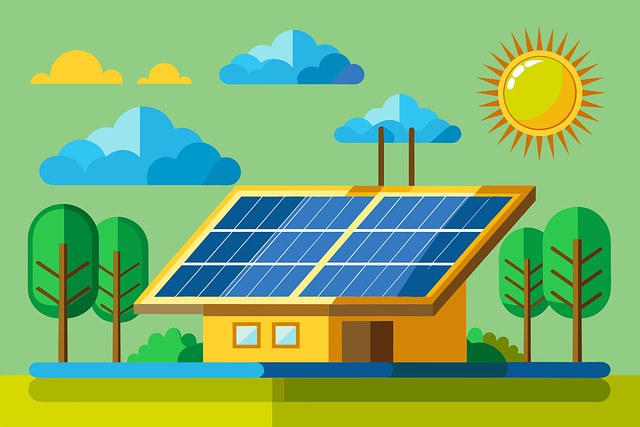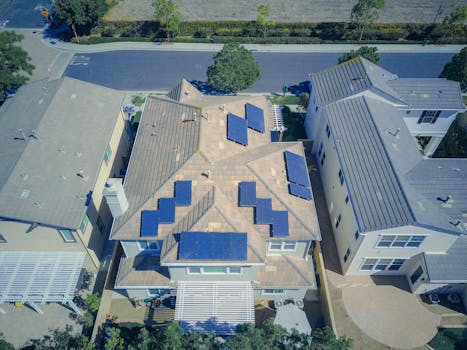“Power Up Your Home: Solar Inverter Installation in 5 Simple Steps!”
**Introduction to Solar Inverter Installation in 5 Easy Steps**
Installing a solar inverter is a crucial step in setting up a solar power system, as it converts the direct current (DC) generated by solar panels into alternating current (AC) for use in homes and businesses. Here’s a simplified guide to help you through the installation process in five easy steps:
1. **Site Assessment**: Evaluate the installation site to determine the best location for the inverter, considering factors like sunlight exposure, accessibility, and proximity to the solar panels and electrical panel.
2. **Gather Tools and Materials**: Collect all necessary tools and materials, including the solar inverter, mounting brackets, wiring, circuit breakers, and safety equipment.
3. **Mount the Inverter**: Securely mount the inverter on a wall or a suitable surface, ensuring it is level and properly ventilated to prevent overheating.
4. **Connect Wiring**: Carefully connect the DC input wires from the solar panels to the inverter and the AC output wires to the electrical panel, following the manufacturer’s instructions and local electrical codes.
5. **Testing and Commissioning**: Once all connections are made, turn on the inverter and test the system to ensure it is functioning correctly, monitoring for any issues before finalizing the installation.
By following these steps, you can successfully install a solar inverter and harness the power of solar energy for your needs.
Choosing The Right Solar Inverter
Choosing the right solar inverter is a crucial step in the solar energy installation process, as it directly impacts the efficiency and performance of your solar power system. With various types of inverters available on the market, understanding their functions and features can help you make an informed decision that aligns with your energy needs and budget. To begin with, it is essential to recognize the different types of solar inverters: string inverters, microinverters, and power optimizers. Each type has its unique advantages and disadvantages, which can significantly influence the overall effectiveness of your solar setup.
String inverters are the most common type used in residential solar installations. They connect multiple solar panels in a series, converting the direct current (DC) generated by the panels into alternating current (AC) for use in your home. While string inverters are generally more affordable and easier to install, they can be less efficient in situations where shading occurs on some panels, as the performance of the entire string can be affected by the weakest link. Therefore, if your roof has shading issues or varying orientations, you may want to consider alternative options.
On the other hand, microinverters are installed on each individual solar panel, allowing for independent operation. This means that if one panel is shaded or underperforming, it will not impact the performance of the others. Microinverters tend to offer higher energy yields, especially in complex roof configurations, but they come at a higher initial cost. Additionally, they can be more challenging to install, requiring a more intricate setup. As you weigh your options, consider your roof’s layout and shading conditions to determine whether the benefits of microinverters justify the additional expense.
Power optimizers serve as a middle ground between string inverters and microinverters. They are installed on each panel but work in conjunction with a central string inverter. This setup allows for improved energy production by optimizing the output of each panel while still benefiting from the cost-effectiveness of a string inverter. Power optimizers can be an excellent choice for homeowners looking to maximize their energy production without fully committing to the higher costs associated with microinverters.
In addition to the type of inverter, it is also essential to consider the inverter’s efficiency rating. The efficiency of a solar inverter indicates how well it converts DC electricity into AC electricity. Higher efficiency ratings mean more energy is converted and less is lost during the process. Look for inverters with efficiency ratings above 95%, as these will provide better performance and return on investment over time. Furthermore, pay attention to the inverter’s warranty and lifespan. A good inverter should come with a warranty of at least 5 to 10 years, with some manufacturers offering extended warranties of up to 25 years.
Lastly, it is advisable to consult with a professional solar installer who can assess your specific energy needs and provide tailored recommendations. They can help you navigate the complexities of inverter selection, ensuring that you choose a system that not only meets your current requirements but also accommodates future energy demands. By taking the time to carefully evaluate your options and seek expert guidance, you can confidently select the right solar inverter that will enhance the efficiency and longevity of your solar energy system. Ultimately, making an informed choice will lead to a more sustainable and cost-effective energy solution for your home.
Preparing For Installation

Preparing for the installation of a solar inverter is a crucial step that can significantly influence the efficiency and longevity of your solar energy system. Before diving into the installation process, it is essential to understand the various components involved and the specific requirements of your home or business. This preparation phase not only ensures a smoother installation but also helps in maximizing the performance of your solar energy system.
First and foremost, it is vital to assess your energy needs. Begin by reviewing your electricity consumption patterns over the past year. This information can typically be found on your utility bills, where you can analyze your monthly usage. Understanding your energy requirements will help you determine the appropriate size and type of solar inverter needed for your system. A well-sized inverter will optimize energy conversion and prevent potential issues related to overloading or underutilization.
Once you have a clear understanding of your energy needs, the next step is to evaluate your property’s solar potential. This involves examining the roof or installation area for any obstructions that may cast shadows on the solar panels, such as trees, chimneys, or neighboring buildings. Ideally, the installation site should receive unobstructed sunlight for most of the day. If you identify any potential shading issues, consider consulting with a solar professional who can provide solutions, such as trimming trees or adjusting the panel layout to maximize sunlight exposure.
In addition to assessing solar potential, it is essential to familiarize yourself with local regulations and permitting requirements. Different regions have varying codes and standards for solar installations, which may include zoning laws, building permits, and electrical codes. Researching these regulations beforehand can save you time and potential headaches during the installation process. Engaging with local authorities or a knowledgeable solar installer can provide clarity on what is required, ensuring that your installation complies with all necessary guidelines.
Moreover, selecting the right solar inverter is a critical aspect of the preparation phase. There are several types of inverters available, including string inverters, microinverters, and power optimizers. Each type has its advantages and disadvantages, depending on your specific installation scenario. For instance, string inverters are often more cost-effective for larger systems, while microinverters can enhance performance in shaded areas. Consulting with a solar expert can help you make an informed decision based on your unique circumstances.
As you move forward in the preparation process, it is also important to consider the installation logistics. This includes determining the best time for installation, which may depend on weather conditions and the availability of your chosen installer. Scheduling the installation during a period of favorable weather can help ensure a smooth process and reduce the risk of delays. Additionally, make sure to clear the installation area of any debris or obstacles to facilitate easy access for the installation team.
Finally, communication with your installer is key. Discuss any concerns or questions you may have regarding the installation process, warranty, and maintenance. Establishing a clear line of communication will not only enhance your understanding of the system but also foster a collaborative relationship with your installer. By taking these preparatory steps, you will be well-equipped for a successful solar inverter installation, paving the way for a sustainable energy future.
Step-By-Step Installation Process
Installing a solar inverter is a crucial step in setting up a solar power system, as it converts the direct current (DC) generated by solar panels into alternating current (AC) that can be used in homes and businesses. The installation process may seem daunting, but by following a systematic approach, it can be accomplished efficiently. Here, we outline a step-by-step installation process that simplifies the task.
To begin with, the first step involves selecting the appropriate location for the inverter. It is essential to choose a spot that is easily accessible for maintenance and monitoring, while also ensuring that it is sheltered from extreme weather conditions. Ideally, the inverter should be installed in a shaded area, such as a garage or a utility room, to prevent overheating. Once the location is determined, the next step is to gather all necessary tools and materials. This typically includes the inverter itself, mounting brackets, screws, a drill, and electrical wiring. Having everything on hand will streamline the installation process and minimize interruptions.
After preparing the site and gathering the tools, the third step is to mount the inverter securely. Begin by attaching the mounting brackets to the wall or surface where the inverter will be installed. It is crucial to ensure that the brackets are level and securely fastened, as this will provide a stable base for the inverter. Once the brackets are in place, carefully hang the inverter onto the brackets, following the manufacturer’s instructions. This step is vital, as a properly mounted inverter will function optimally and reduce the risk of damage.
Following the successful mounting of the inverter, the fourth step involves connecting the electrical wiring. This part of the process requires careful attention to detail, as improper connections can lead to system failures or safety hazards. Start by connecting the DC input wires from the solar panels to the inverter. It is important to ensure that the polarity is correct, as reversing the connections can damage the inverter. After securing the DC connections, proceed to connect the AC output wires to the electrical panel. This step may require the assistance of a licensed electrician, especially if you are unfamiliar with electrical systems. Ensuring that all connections are tight and secure will help prevent any potential issues down the line.
Once the wiring is complete, the final step is to configure and test the inverter. Most modern inverters come with a user-friendly interface that allows for easy setup. Follow the manufacturer’s instructions to configure the settings, which may include inputting information about the solar panel system and setting up monitoring options. After configuration, it is essential to conduct a thorough test to ensure that the inverter is functioning correctly. This involves checking the display for any error messages and verifying that the system is generating power as expected.
In conclusion, installing a solar inverter can be accomplished in five straightforward steps: selecting the location, gathering tools, mounting the inverter, connecting the wiring, and configuring the system. By following this systematic approach, homeowners and businesses can ensure a successful installation that maximizes the efficiency of their solar power systems. With the right preparation and attention to detail, the transition to solar energy can be both seamless and rewarding.
Post-Installation Testing And Maintenance
Once the solar inverter has been successfully installed, the next crucial phase involves post-installation testing and maintenance to ensure optimal performance and longevity of the system. This step is essential not only for verifying that the installation was executed correctly but also for confirming that the inverter operates efficiently within the solar energy system. To begin with, it is vital to conduct a thorough inspection of the entire installation. This includes checking all electrical connections, ensuring that the wiring is secure, and verifying that there are no visible signs of damage or wear. A meticulous examination at this stage can prevent potential issues down the line, thereby safeguarding the investment in solar technology.
Following the visual inspection, the next step is to perform functional testing of the inverter. This involves powering up the system and monitoring its performance under various conditions. During this phase, it is important to check the inverter’s display panel for any error codes or warning signals. These indicators can provide valuable insights into the operational status of the inverter and highlight any immediate concerns that need to be addressed. Additionally, testing the inverter’s output voltage and current can help ensure that it is converting the direct current (DC) generated by the solar panels into alternating current (AC) effectively. This step is crucial, as any discrepancies in output can lead to inefficiencies in energy production.
Once the initial testing is complete, it is advisable to monitor the system’s performance over a period of time. This ongoing observation allows for the identification of any irregularities that may not have been apparent during the initial testing phase. Utilizing monitoring software can greatly enhance this process, as many modern inverters come equipped with built-in monitoring capabilities. These systems can provide real-time data on energy production, system efficiency, and any potential faults. By regularly reviewing this data, homeowners can ensure that their solar energy system is functioning at its peak performance.
In addition to monitoring, regular maintenance is essential for the longevity of the solar inverter. This maintenance should include periodic cleaning of the inverter and surrounding areas to prevent dust and debris from accumulating, which can hinder performance. Furthermore, it is important to check the inverter’s cooling system, as overheating can lead to reduced efficiency or even damage. Ensuring that the inverter is well-ventilated and free from obstructions will help maintain optimal operating temperatures.
Moreover, scheduling professional inspections at least once a year can provide an additional layer of assurance. During these inspections, qualified technicians can perform more in-depth assessments, including testing the inverter’s efficiency and checking for any signs of wear or potential failure. This proactive approach not only helps in identifying issues before they escalate but also extends the lifespan of the inverter.
In conclusion, post-installation testing and maintenance are critical components of a successful solar inverter installation. By conducting thorough inspections, performing functional tests, monitoring performance, and adhering to a regular maintenance schedule, homeowners can ensure that their solar energy systems operate efficiently and effectively. This diligence not only maximizes energy production but also enhances the overall return on investment, making solar energy a sustainable and reliable choice for the future.
Q&A
1. **Question:** What is the first step in solar inverter installation?
**Answer:** The first step is to assess the site and determine the appropriate location for the inverter, ensuring it is close to the solar panels and the electrical panel.
2. **Question:** What is the second step in the installation process?
**Answer:** The second step is to mount the inverter securely on a wall or a suitable surface, ensuring it is level and accessible for maintenance.
3. **Question:** What is the third step in solar inverter installation?
**Answer:** The third step is to connect the solar panel wiring to the inverter, following the manufacturer’s instructions for proper polarity and connections.
4. **Question:** What is the final step in the installation process?
**Answer:** The final step is to connect the inverter to the electrical panel and perform a system check to ensure everything is functioning correctly before turning on the system.
Conclusion
1. **Site Assessment**: Evaluate the location for solar panel installation, considering factors like sunlight exposure, roof condition, and shading.
2. **Select the Right Inverter**: Choose an appropriate solar inverter type (string, micro, or central) based on the system size and design.
3. **Electrical Setup**: Prepare the electrical connections, ensuring compliance with local codes and safety standards, including circuit breakers and grounding.
4. **Mounting the Inverter**: Securely install the inverter in a suitable location, typically close to the solar panels and the main electrical panel, ensuring proper ventilation.
5. **System Testing and Commissioning**: After installation, conduct thorough testing to ensure the inverter operates correctly, followed by connecting it to the grid and monitoring performance.




